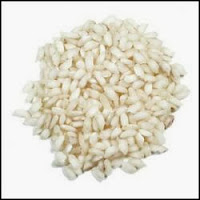Risotto is a dish that you can add more or less of what you like to. When I make butternut squash risotto, I like to add a cup of peas to the mix about half way through the cooking. This adds a nice splash of colour to the dish.
I frequently serve this dish with fish to make it a non-vegetarian meal.
It starts with the rice
 |
| Arborio Rice |
Risotto rice contains more starch than other rices that are used in most cooking. This is what gives your risotto its creamy texture.
The grains are short, fat, and slightly oval shaped. Because it undergoes less milling than most rice, it retains more of the natural starches.
A pound of arborio rice can absorb up to 6 cups of liquid without becoming mushy.
"Oryza sativa, the Latin name for rice, was first cultivated in Italy around the fifteenth century. The japonica subspecies forms a round and large grain, grown for its starchy qualities - indispensable when making risotto. The types include carnaroli, vialone nano, arborio and, less well known, baldo."
~ From the Official Antonio Carluccio web site
Basic Risotto

Risotto cooking

2 tbsp olive oil
55g (2 oz) butter
350g (12 oz) risotto rice
1.7 litres (3 pints) vegetable stock, simmering
55g (2 oz) Parmesan, freshly grated (omit or substitute vegan parmesan if making a vegan mean)
Salt and pepper to taste
Use a heavy saucepan with a rounded bottom, big enough to contain the rice, plus the liquid. Heat the oil and half the butter in this, then add and carefully coat the rice before adding any liquid. Turn the rice with a wooden spoon. You start to add the boiling stock when the rice is well and truly impregnated with butter and starts to stick to the bottom of the pan. Add only a ladleful at a time. Continue to stir and add the stock until the rice appears to be cooked (after 20 - 25 minutes).
At this stage remove the pan from the heat and, without stirring, let the rice absorb the last of the liquid. The risotto should have a creamy consistency,but the grains should still be firm to the bite (al dente). Just before serving (with the exception of seafood risottos), stir in the remaining butter and the freshly grated Parmesan. This last operation is called 'mantecare', possibly from the Spanish 'manteca' which means 'fat'. Taste finally for the right seasoning and serve straightaway. It is important to time the cooking so that this little work of art can be enjoyed and fully appreciated the moment the cheese has melted and the risotto is ready.
Butternut Squash Risotto
Follow the recipe as directed above.After adding the rice, before adding the liquid, add 1/2 butternut squash (peeled and cut into bite size or smaller pieces).
Continue to stir and add fluid as directed.
As the risotto cooks the butternut squash will cook and break down, adding to the creaminess of the risotto. I like to cut the squash into varying sizes between bite-sized and smaller. That way some pieces are broken down completely while others remain somewhat intact.
Arborio Risotto Rice 500 g


No comments:
Post a Comment
Thank you for commenting. If you have question I will answer you as soon as possible.